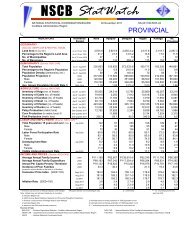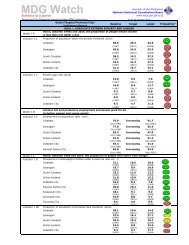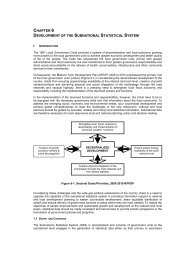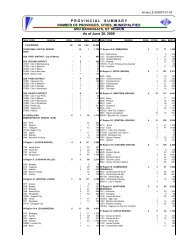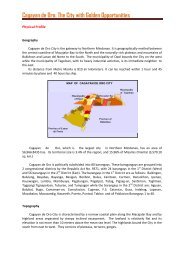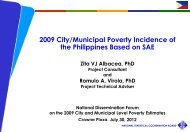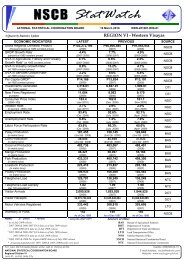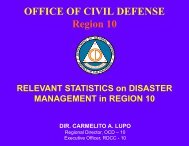Accumulation of Mercury and Other Heavy Metals in Some ... - NSCB
Accumulation of Mercury and Other Heavy Metals in Some ... - NSCB
Accumulation of Mercury and Other Heavy Metals in Some ... - NSCB
You also want an ePaper? Increase the reach of your titles
YUMPU automatically turns print PDFs into web optimized ePapers that Google loves.
<strong>Accumulation</strong> <strong>of</strong> <strong>Mercury</strong> <strong>and</strong> <strong>Other</strong> <strong>Heavy</strong> <strong>Metals</strong> <strong>in</strong> <strong>Some</strong>Edible Mar<strong>in</strong>e Mollusks <strong>in</strong> Sibutad, Zamboanga del NortebyGeorg<strong>in</strong>a Lacastesantos - Fern<strong>and</strong>ez 1ABSTRACTThis study was conducted to assess the impact <strong>of</strong> gold m<strong>in</strong><strong>in</strong>g activitieson the nearby mar<strong>in</strong>e bay. We <strong>in</strong>vestigated the fate <strong>of</strong> mercury (hg) among thedifferent environmental compartments (water, sediment, suspended particulates,organisms) <strong>and</strong> its relative distribution among 10 <strong>of</strong> the most common<strong>in</strong>vertebrate species found <strong>in</strong> the bay.Sampl<strong>in</strong>g was done from October 25-29, 1999 <strong>in</strong> 10 sampl<strong>in</strong>g stationswith<strong>in</strong> the bay. Samples were kept frozen <strong>and</strong> later analyzed at the BiologyLaboratory <strong>of</strong> the University <strong>of</strong> Antwerp, Belgium. The mercury discussed <strong>in</strong> thispaper relates to total mercury only.Results <strong>of</strong> analyses showed that all the sampl<strong>in</strong>g sites <strong>in</strong> the bayexceeded the allowable Hg limit for seawater (2ppb). Stations nearest <strong>in</strong>proximity to the m<strong>in</strong><strong>in</strong>g area tend to acquire higher concentrations <strong>in</strong> all thecompartments. Among the species, Modiolus philipp<strong>in</strong>arum, Nerita planospira<strong>and</strong> Trachycardium flavum were with<strong>in</strong> the allowable limit <strong>of</strong> 0.5 ppm. Tectusfenestratus, Strombus sp, Placuna ephippium <strong>and</strong> Circe scripta had as much asa factor <strong>of</strong> 5 more than the allowable limit. From regression analysis, this studyhas shown that mercury concentration <strong>in</strong> tissues <strong>of</strong> 3 out <strong>of</strong> 4 species studiedcorrelated with dissolved mercury <strong>and</strong> suspended particles or sediments. Lack<strong>of</strong> consistent correlations between dissolved or particulate Hg <strong>and</strong> tissueconcentrations were observed <strong>in</strong> Modiolus philipp<strong>in</strong>arum (a bivalve) though itshowed high levels <strong>of</strong> mercury.This study has shown that there are some <strong>in</strong>teractions/associationsamong metals dur<strong>in</strong>g accumulation process <strong>in</strong> several species. However, wewere not able to establish the mechanism that control these<strong>in</strong>teraction/associations.I. Introduction<strong>Heavy</strong> metals such as mercury, lead, arsenic, cadmium, t<strong>in</strong>, chromium,z<strong>in</strong>c, <strong>and</strong> copper are among the most dangerous pollutants <strong>in</strong> the mar<strong>in</strong>eenvironment (Goldberg, 1975; Philips, 1980; Cossa, 1988; Ross, 1988;Schuhmacher <strong>and</strong> Dom<strong>in</strong>go, 1996; Nebel <strong>and</strong> Wright, 1996). Due to its uniqueproperties, mercury is used <strong>in</strong> medical <strong>and</strong> scientific <strong>in</strong>struments likethermometers, manometers <strong>and</strong> barometers, jewelry mak<strong>in</strong>g, for coat<strong>in</strong>g the back<strong>of</strong> mirrors, <strong>in</strong> dental amalgams, as catalyst <strong>in</strong> the production <strong>of</strong> polyurethanefoams, <strong>in</strong> pr<strong>in</strong>t<strong>in</strong>g <strong>and</strong> <strong>in</strong> the extraction <strong>of</strong> gold <strong>and</strong> silver (Dugan, 1972; Sittig,1980; Bunce, 1991; Huber, 1997; STAO, 1992; USEPA, 1997; ATSDR, 1999).<strong>Mercury</strong> cycles <strong>in</strong> the environment as a result <strong>of</strong> natural processes such asvolatilization <strong>of</strong> mercury <strong>in</strong> mar<strong>in</strong>e <strong>and</strong> aquatic environments, from vegetation,degass<strong>in</strong>g <strong>of</strong> geologic materials <strong>and</strong> volcanic emissions <strong>and</strong> anthropogenicactivities, dom<strong>in</strong>ated by <strong>in</strong>dustrial processes <strong>and</strong> combustion sources (T<strong>in</strong>ggi <strong>and</strong>Craven, 1996; Park <strong>and</strong> Curtis, 1997). Most <strong>of</strong> the mercury <strong>in</strong> the atmosphere is1 Ecosystems Management Specialist II, PAWCZMS, DENR-IX, Zamboanga Pen<strong>in</strong>sula.



